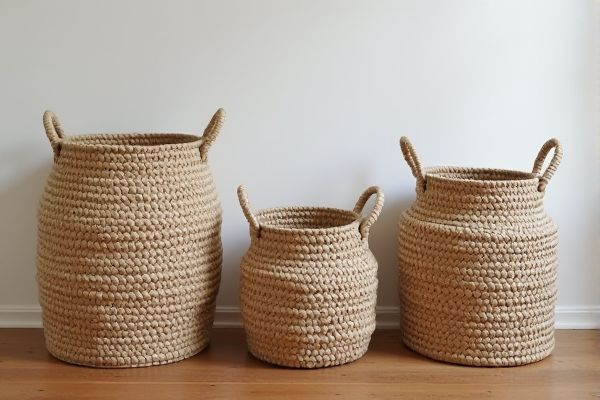
Grid baskets offer improved airflow and visibility, making them ideal for dry storage and easy item identification, while solid baskets provide better containment and protection from dust or spills, perfect for delicate or small items. Explore the rest of the article to discover which basket type best suits Your organizational needs.
Table of Comparison
| Feature | Grid Baskets | Solid Baskets |
|---|---|---|
| Material Structure | Open grid pattern with spaces | Fully enclosed solid surface |
| Ventilation | Excellent airflow and drainage | Poor ventilation, retains moisture |
| Visibility | Easy to see contents | Contents hidden from view |
| Durability | Strong but can warp if overloaded | Highly durable and rigid |
| Weight | Lighter due to open design | Heavier due to solid material |
| Best Use Cases | Storage requiring airflow - fruits, vegetables | Storage needing protection and containment |
| Cleaning | Easy to clean with minimal residue buildup | Can retain dirt; requires thorough cleaning |
Introduction to Grid Baskets and Solid Baskets
Grid baskets feature an open, wireframe structure allowing maximum airflow and visibility, ideal for storing fresh produce or organizing tools. Solid baskets provide a sturdy, enclosed design that prevents smaller items from falling through, making them suitable for storing loose or delicate objects. Choosing between grid and solid baskets depends on the need for ventilation and containment in storage solutions.
Material Composition and Durability
Grid baskets are typically made from metal wire or reinforced plastic, offering excellent airflow and moisture resistance, which enhances their durability in humid environments. Solid baskets, often constructed from solid plastic or metal sheets, provide sturdier containment but may retain moisture, potentially affecting longevity depending on usage. Your choice between grid and solid baskets should consider the balance between airflow needs and the material's resistance to wear over time.
Design Differences and Aesthetics
Grid baskets feature an open pattern of evenly spaced wires or bars, creating a lightweight, airy appearance that enhances visibility and ventilation. Solid baskets, constructed from continuous, unbroken materials like metal or plastic, offer a sleek, minimalist look with a uniform surface that emphasizes durability and privacy. The choice between grid and solid baskets impacts both the functional design aspects and the overall visual appeal, catering to different aesthetic preferences and usage needs.
Ventilation and Moisture Control
Grid baskets provide superior ventilation compared to solid baskets due to their open design, allowing air to circulate freely and reducing moisture buildup. This improved airflow helps prevent mold and mildew, keeping contents dry and fresh for longer periods. Your choice of grid baskets enhances moisture control, making them ideal for storing items prone to dampness.
Weight Capacity and Load Distribution
Grid baskets offer superior load distribution due to their open structure, which allows weight to be evenly spread across multiple points, reducing stress on individual sections. Solid baskets, while typically heavier, can handle higher individual weights but may concentrate load unevenly, increasing the risk of deformation under heavy or irregular loads. When selecting the right basket for your needs, consider grid baskets for balanced weight capacity and improved durability in varied load situations.
Cleaning and Maintenance Requirements
Grid baskets offer easier cleaning and maintenance due to their open design, allowing water and cleaning solutions to pass through freely, preventing buildup of debris. Solid baskets, while providing a more contained structure, often require more frequent manual scrubbing to remove trapped dirt and residue. Your choice depends on how much time you want to spend on upkeep versus the type of debris you typically handle.
Storage Versatility and Practical Uses
Grid baskets offer superior storage versatility by allowing visibility and airflow, making them ideal for organizing items like fruits, vegetables, and pantry goods that benefit from ventilation. Solid baskets provide practical uses for storing small, loose items or materials sensitive to dust and light, creating a clean and contained storage solution. Both basket types enhance organization but cater to different needs based on the nature of stored items and desired accessibility.
Cost Comparison and Value for Money
Grid baskets generally cost less upfront than solid baskets due to their simpler construction and reduced material usage. Solid baskets provide enhanced durability and protection, potentially lowering long-term replacement costs and offering better value for money in environments requiring heavy-duty performance. Investing in solid baskets can result in cost savings over time, despite a higher initial price, by minimizing damage and maintenance expenses.
Environmental Impact and Sustainability
Grid baskets promote sustainability by using less material and allowing debris to pass through, reducing water treatment energy consumption and waste buildup. Solid baskets, typically made from more plastic or metal, contribute to higher resource use and longer decomposition times in landfills. Choosing grid baskets supports eco-friendly water filtration practices by minimizing environmental footprint and enhancing recyclability.
Choosing the Right Basket for Your Needs
Grid baskets offer superior ventilation and visibility, making them ideal for storing items that require airflow, such as fruits, vegetables, or laundry. Solid baskets provide enhanced privacy and protection from dust, suitable for delicate clothes, personal items, or when a cleaner aesthetic is desired. Selecting the right basket depends on your storage needs, prioritizing breathability with grid baskets or coverage and concealment with solid baskets.
 homyna.com
homyna.com